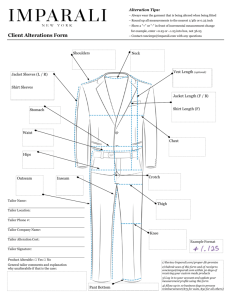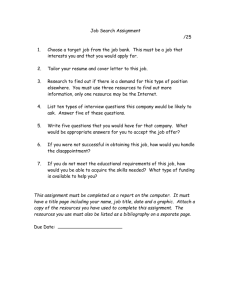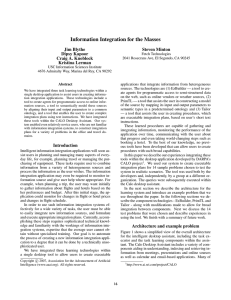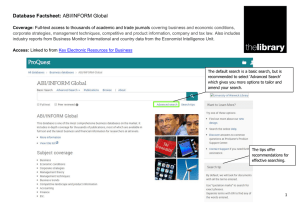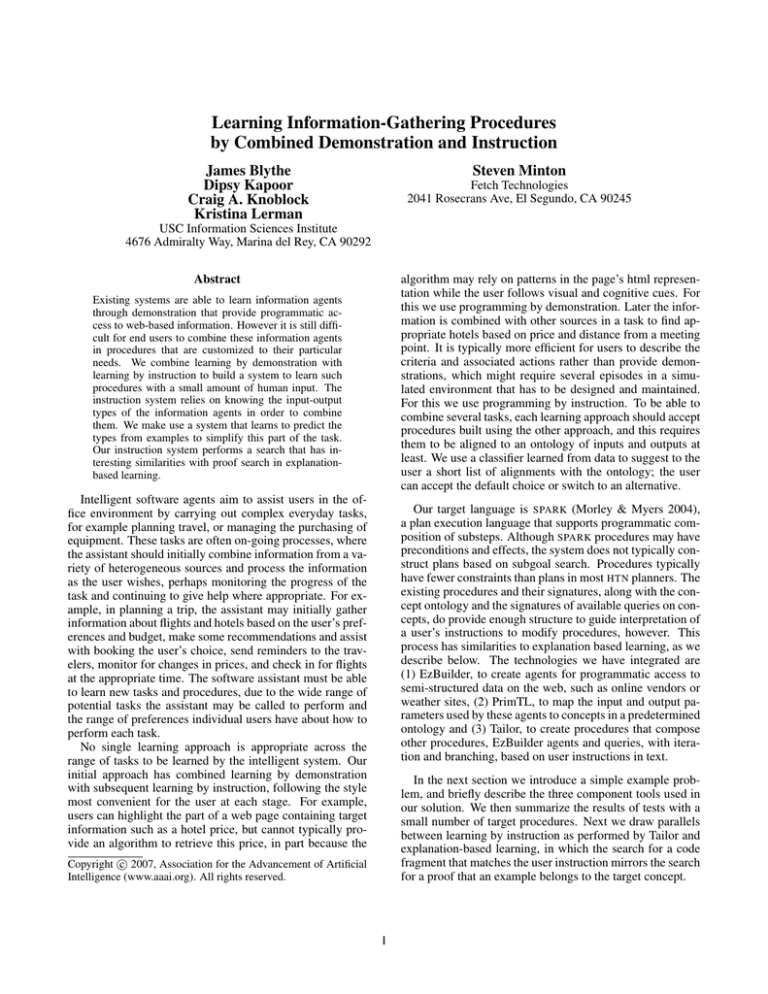
Learning Information-Gathering Procedures
by Combined Demonstration and Instruction
Steven Minton
James Blythe
Dipsy Kapoor
Craig A. Knoblock
Kristina Lerman
Fetch Technologies
2041 Rosecrans Ave, El Segundo, CA 90245
USC Information Sciences Institute
4676 Admiralty Way, Marina del Rey, CA 90292
Abstract
algorithm may rely on patterns in the page’s html representation while the user follows visual and cognitive cues. For
this we use programming by demonstration. Later the information is combined with other sources in a task to find appropriate hotels based on price and distance from a meeting
point. It is typically more efficient for users to describe the
criteria and associated actions rather than provide demonstrations, which might require several episodes in a simulated environment that has to be designed and maintained.
For this we use programming by instruction. To be able to
combine several tasks, each learning approach should accept
procedures built using the other approach, and this requires
them to be aligned to an ontology of inputs and outputs at
least. We use a classifier learned from data to suggest to the
user a short list of alignments with the ontology; the user
can accept the default choice or switch to an alternative.
Existing systems are able to learn information agents
through demonstration that provide programmatic access to web-based information. However it is still difficult for end users to combine these information agents
in procedures that are customized to their particular
needs. We combine learning by demonstration with
learning by instruction to build a system to learn such
procedures with a small amount of human input. The
instruction system relies on knowing the input-output
types of the information agents in order to combine
them. We make use a system that learns to predict the
types from examples to simplify this part of the task.
Our instruction system performs a search that has interesting similarities with proof search in explanationbased learning.
Intelligent software agents aim to assist users in the office environment by carrying out complex everyday tasks,
for example planning travel, or managing the purchasing of
equipment. These tasks are often on-going processes, where
the assistant should initially combine information from a variety of heterogeneous sources and process the information
as the user wishes, perhaps monitoring the progress of the
task and continuing to give help where appropriate. For example, in planning a trip, the assistant may initially gather
information about flights and hotels based on the user’s preferences and budget, make some recommendations and assist
with booking the user’s choice, send reminders to the travelers, monitor for changes in prices, and check in for flights
at the appropriate time. The software assistant must be able
to learn new tasks and procedures, due to the wide range of
potential tasks the assistant may be called to perform and
the range of preferences individual users have about how to
perform each task.
No single learning approach is appropriate across the
range of tasks to be learned by the intelligent system. Our
initial approach has combined learning by demonstration
with subsequent learning by instruction, following the style
most convenient for the user at each stage. For example,
users can highlight the part of a web page containing target
information such as a hotel price, but cannot typically provide an algorithm to retrieve this price, in part because the
Our target language is SPARK (Morley & Myers 2004),
a plan execution language that supports programmatic composition of substeps. Although SPARK procedures may have
preconditions and effects, the system does not typically construct plans based on subgoal search. Procedures typically
have fewer constraints than plans in most HTN planners. The
existing procedures and their signatures, along with the concept ontology and the signatures of available queries on concepts, do provide enough structure to guide interpretation of
a user’s instructions to modify procedures, however. This
process has similarities to explanation based learning, as we
describe below. The technologies we have integrated are
(1) EzBuilder, to create agents for programmatic access to
semi-structured data on the web, such as online vendors or
weather sites, (2) PrimTL, to map the input and output parameters used by these agents to concepts in a predetermined
ontology and (3) Tailor, to create procedures that compose
other procedures, EzBuilder agents and queries, with iteration and branching, based on user instructions in text.
In the next section we introduce a simple example problem, and briefly describe the three component tools used in
our solution. We then summarize the results of tests with a
small number of target procedures. Next we draw parallels
between learning by instruction as performed by Tailor and
explanation-based learning, in which the search for a code
fragment that matches the user instruction mirrors the search
for a proof that an example belongs to the target concept.
c 2007, Association for the Advancement of Artificial
Copyright Intelligence (www.aaai.org). All rights reserved.
1
Example problem and component systems
instance created by the user as shown in Figure 1. EzBuilder
then analyzes the HTML and learns extraction rules for the
required data (Muslea, Minton, & Knoblock 2001). Typically one to three samples are needed. However, if there is
some variation in the format or layout of the page, the user
may need to mark up additional samples so that the wrapper
can learn general enough extraction rules.
Suppose the user is planning to travel and wishes to make
use of a new online site for hotels and rates. First she builds
a procedure to access the site, requiring a city name and returning a list of hotels, with a set of features available for
each hotel. Next, she creates a procedure that uses the first
one to find a set of available hotels within a fixed distance of
a location. This procedure can be called with different locations, dates and distance thresholds. After choosing a hotel,
the user would like to be informed if the rate subsequently
drops. She creates a third procedure, also using the first one,
that the assistant will invoke daily to check the rate against
the booked rate, and email her if it has dropped.
PrimTL: Aligning primitive procedures to a type
hierarchy
Although the newly created agent is now available for querying information sources, it cannot be used programmatically
by other CALO components because its input and output parameters are not yet aligned with a common ontology. This
is done by PrimTL, automatically launched after EzBuilder
exits, which assists the user in semantically annotating the
input and output parameters used by the source and linking
them to a common CALO ontology.
Our classifier learns a model of data from known sources
and uses the models to recognize new instances of the
same semantic types on new sources (Lerman, Plangprasopchok, & Knoblock 2006). The classifier uses a
domain-independent pattern language (Lerman, Minton, &
Knoblock 2003) to represent the content of data as a sequence of tokens or token types. These can be specific
tokens, such as ‘90292’, as well as general token types,
‘5DIGIT’ or ‘NUMBER’. The general types have regular
expression-like recognizers.
Data models can be efficiently learned from examples of a
semantic type. We have accumulated a collection of learned
models for about 80 semantic types using data from a large
body of Web agents created by our group over the years. We
can use the learned models to recognize new instances of the
semantic type by evaluating how well the model describes
the instances of the semantic type.
PrimTL reads data collected by EzBuilder, and uses the
classifier to present to the user a ranked list of the top choices
of the semantic type for each parameter. The semantic labeling step for the OnlineReservationZ agent is shown in
Figure 2. The top scoring choice for each semantic type is
displayed next to the parameter label. The user can see the
other choices, and select one of them if appropriate.
EzBuilder: Automating access to web information
sources
Fetch Technologies’ EzBuilder tool helps the user create
agents that can automatically query and extract data from
information sources. Most online information sources are
designed for humans, not computer programs, affecting how
the site is organized and how information is laid out on its
pages. The hotel reservations site shown on the right in Figure 1 allows user to search for hotels available in a specified
city on specified dates. To build an agent for this site, the
user demonstrates to EzBuilder how to obtain the required
information by filling out forms and navigating the site to
the detail pages, just as she would in a Web browser.
Tailor: customized composition of information
sources
Once the agent is aligned with the ontology, it can be used
in the body of compound procedures that combine calls to
other procedures along with iteration and branching. Tailor
allows the user to create procedures by giving short instructions about the steps in the procedures, their parameters and
conditions under which they are performed. By mapping
the instructions into syntactically valid fragments of code
and describing the results in a natural interface, Tailor allows users to create executable procedures without detailed
knowledge of the syntax of the procedures or the ontology
they use (Blythe 2005a; 2005b).
Tailor helps a user create or modify a procedure with an
instruction in two main steps: modification identification
Figure 1: Schema definition for a hotel agent using the “Online Reservations” site. The user defines output fields such
as “hotel name” and “hotel city”, then drags the relevant text
from the page over each output field for each page used in
training.
As the user navigates the site, EzBuilder creates a model
describing how to find pages of interest for a query. Next,
the user specifies what data she wants from the site (in this
case, name, address, price etc.) and trains EzBuilder to extract it, by dragging the relevant text on the page to a schema
2
Figure 2: PrimTL’s semantic mapping editor uses the training examples to predict the type of the agent’s inputs and
outputs based on their content. The user can correct a prediction if needed, choosing from PrimTL’s top choices or
from the whole type hierarchy.
and analysis. In modification identification, Tailor classifies
a user instruction as one of a set of action types, for example adding a new substep, or adding a condition to a step.
The instruction ”only list a hotel if the distance is below two
miles”, for example, would be classified as the latter. This is
done largely by keyword analysis.
Tailor also searchs for the step or condition parameters.
For example, the phrase ”if the distance is below two miles”
will be used to provide the condition that is being added to
a step. The mapped condition may require several database
queries and several auxiliary procedure steps. In the current example, a separate procedure that finds distances based
on two addresses from an online source is called before
the numeric comparison in the condition, and provides input to it. Tailor finds potential multi-step and multi-query
matches through a dynamic programming search (Blythe
2005a). The ability to match multiple actions and queries
is essential to bridge the gap between the user’s instruction
and a working procedure, and is used in the interpretation of
most instructions.
In modification analysis, Tailor checks the potential procedure change indicated by the instruction to see if any new
problems might be introduced with the set of procedures that
are combined within the new procedure definition. For example, deleting a step, or adding a condition to its execution,
may remove a variable that is required by some later step in
the procedure. If this is the case, Tailor warns the user and
presents a menu of possible remedies, such as providing the
information in an alternate way.
Tailor maintains the procedure internally in SPARK’s format as it is being built, and shows the user an automaticallygenerated text description. A SPARK-like version of the procedure being developed in Figure 3 is as follows.
Figure 3: Tailor shows its interpretation of the user instruction and the resulting new procedure.
[seq:
[context: (startDate?meeting?Date4)]
[context: (componentLocationCity?location?City5)]
[context: (endDate?meeting?Date6)]
[do:(getHotels?Date4?Date6?City5?hotelData6)]
[do:(convertXMLToList?hotelData6?Listhotel7)]
[forin:?hotel8?Listhotel7
[seq:
[do:(fetchAttribute?hotel8“hotelLocation”?Location8)]
[do:(getYahooDistance?location?Location8?distanceData4)]
[do:(extractObject?distanceData4?distance5)]
[do:(fetchAttribute?distance5“dist”?DistanceMiles6)]
[do:(stringToLeadingNumber?DistanceMiles6?Number7)]
[select:
(<?Number72)
[do:(fetchAttribute?hotel8“hotelName”?Hotelname1)]
(True)
[succeed:]]]]]
)
Results and discussion
We used the combined system for 14 test problems relating
to travel and organizing meetings that together required 11
information sources. Typical problems in these domains are:
“List hotels within ?N miles of the ?Meeting that have the
features (?F1, . . . ?Fn)”, “Notify the attendees of ?Meeting
of a room change” and “Who is attending ?Conference that
(defprocedurelistHotelsNearAtProc
doc:“AddedbyTailor”
cue:[do:(listHotelsNearAt?meeting?location)]
precondition:(True)
body:
3
In general, many potential procedure fragments must be
generated very quickly to provide a seamless user experience. Tailor uses a dynamic programming approach to
achieve this (Blythe 2005a). Our combination of demonstration and instruction allows rich procedural definitions to
be learned from a very small number of examples combined
with user input.
could present a poster at ?Time?”. In these examples, we
use “?” to denote a variable.
Agents were built for the information sources with
EzBuilder, then PrimTL was used to predict the type of the
inputs and outputs based on the content. The correct semantic type was often the top prediction, and for more than
half of the sources, it was among the top four predictions.
F-measures for the predicted type are at 0.8 or above for
7 of the 11 agents when we require the correct type to be
PrimTL’s first choice, and for 10 of the agents when the correct type must be one of the top four choices.
Working with correctly-labelled information agents, full
procedures were successfully built using Tailor in each of
the 14 test problems. The tool was also used successfully by
another group to build these procedures and to define a new
procedure in the same domain.
Related work
Our system is similar to information mediators, which provide a uniform access to heterogeneous data sources. To
integrate information from multiple sources with a mediator, the user has to define a domain model (schema) and
relate it to the predicates used by the source. The queries
are posed to the mediator using the domain model and are
then reformulated into the source schemas. The mediator
dynamically generates an execution plan and passes it to an
execution engine that sends the appropriate sub-queries to
the sources and evaluates the results (Thakkar, Ambite, &
Knoblock 2005). Our system is different on a number of
levels: (1) it attempts to automatically model the source by
inferring the semantic types of its inputs and outputs; (2) instead of a query, the system assists the user in constructing
executable plans, or procedures that (3) may contain worldchanging steps or steps with no effects according to the system’s model.
Much of the work in procedure learning relies on user
demonstration (Lieberman 2001; Oblinger, Castelli, &
Bergman 2006; Lau et al. 2004). The user steps through a
task and the system captures the steps, optionally variablizing and generalizing them. This is intuitive for users, but in
some cases several examples may be required to find the correct generalization, and some aspects of a scenario may be
hard to duplicate for demonstration. Tailor requires instruction, which forces the user to articulate the general terms of
the procedure, but can be faster and require less infrastructure. One of the earliest such systems was Instructo-Soar
(Huffman & Laird 1995) that learned rules for the Soar system.
Explaining user instructions
The interpretation of user instructions in Tailor is similar to
explanation-based learning. Given the user instruction, Tailor searches for a matching code fragment that plays a similar role to a proof. This fragment exploits the structure of
the domain to provide a strong bias on the set of possible
interpretations, exploiting the typing of the constituent procedures and of queries in the domain (marked with “context”
in the SPARK fragment shown above).
Instead of a target concept, however, the context of the instruction provides a target location in the existing procedure
that is to be changed. Rather than a proof, Tailor constructs
a procedure fragment by composing procedures, queries and
language constructs that provides an output value that can be
used in the desired location. As an additional constraint, the
procedure fragment should have a description that loosely
matches the user instruction. Our current definition of a
match requires that the words in the user instruction that
specify the procedure fragment should appear in the language rendering of the fragment. Completing the analogy,
the instruction is best viewed as part of the learning example, since it biases the search to produce results that it may
not otherwise produce, just as the example in explanationbased learning leads to one of potentially many explanations
of the target concept.
For example, in Figure 3, a condition is to be added to the
step to retrieve each hotel name. The words are “distance
less than 2”. A natural candidate is to compare some number with 2, and then the fragment that generates the number should include the word “distance”. Tailor finds the
EzBuilder agent “getYahooDistance” satisfying this condition. Its inputs are locations, which match the input of the
procedure or the location of the hotel. Tailor searches for
a procedure fragment in which the inputs and outputs are
matched on types, and this leads it to insert several auxiliary
tasks as needed into the fragment. For example, it processes
the result of the distance agent, which is a string in XML
format, to extract the distance value before making the comparison. Given the instruction “if hotel distance less than 2”,
it uses an auxiliary procedure to extract the location of the
hotel and uses this in the distance function.
Conclusions and Future Work
We have described an approach that combines learning
by demonstration and instruction to allow end users to
build procedures that compose information-gathering primitive procedures and customize their use. We combine the
strengths of the approaches, incorporating demonstration for
a task that the user would find difficult to describe verbally,
and using instructions to add conditions or to fine-tune steps
in ways that may be cumbersome to achieve through demonstration.
We are exploring several paths of future work. In type
prediction we are exploring recognizing complex types that
are composed of more primitive types, for example a date
is composed of a day, month and year. This allows orderindependent generalization as well as a reduction in the
number of parameters for procedures and queries and a corresponding reduction in search complexity. In Tailor, we
are exploring the use of a form of case-based reasoning to
exploit information from previously-defined procedures. If
4
there are arbitrary choices to make in the parameters of a
new step, for example, matching similar procedures that use
such a step can provide strong hints for the best choices. We
are also investigating how to incorporate stronger constraints
into the search, for example that a hotel check-out date must
come after the check-in date or that distances functions are
symmetric.
Acknowledgments
We gratefully acknowledge valuable conversations with
other members of the Calo task learning group at ISI, including Jose-Luis Ambite and Tom Russ. This material is
based upon work supported by the Defense Advanced Research Projects Agency (DARPA), through the Department
of the Interior, NBC, Acquisition Services Division, under
Contract No. NBCHD030010.
References
Blythe, J. 2005a. An analysis of task learning by instruction. In Proceedings of AAAI-2005.
Blythe, J. 2005b. Task learning by instruction in tailor.
Proceedings of the 10th international conference on Intelligent user interfaces.
Huffman, S. B., and Laird, J. E. 1995. Flexibly instructable
agents. Journal of Artificial Intelligence Research 3:271–
324.
Lau, T.; Bergman, L.; Castelli, V.; and Oblinger, D. 2004.
Sheepdog: Learning procedures for technical support. Proceedings of the 9th international conference on Intelligent
user interfaces.
Lerman, K.; Minton, S.; and Knoblock, C. A. 2003. Wrapper maintenance: A machine learning approach. Journal of
Artificial Intelligence Research 18:149–181.
Lerman, K.; Plangprasopchok, A.; and Knoblock, C. A.
2006. Automatically labeling the inputs and outputs of web
services. In Proceedings of AAAI-2006 93–114.
Lieberman, H. 2001. Your Wish is my Command. Morgan
Kaufmann Press.
Morley, D., and Myers, K. 2004. The spark agent framework. Proceedings of the Third International Joint Conference on Autonomous Agents and Multiagent Systems
2:714–721.
Muslea, I.; Minton, S.; and Knoblock, C. A. 2001. Hierarchical wrapper induction for semistructured information sources. Autonomous Agents and Multi-Agent Systems
4(1/2):93–114.
Oblinger, D.; Castelli, V.; and Bergman, L. 2006.
Augmentation-based learning: combining observations
and user edits for programming-by-demonstration. Proceedings of the 11th international conference on Intelligent
user interfaces 202–209.
Thakkar, S.; Ambite, J. L.; and Knoblock, C. A. 2005.
Composing, optimizing and executing plans for bioinformatics web services. The VLDB Journal 14(3):330–353.
5

